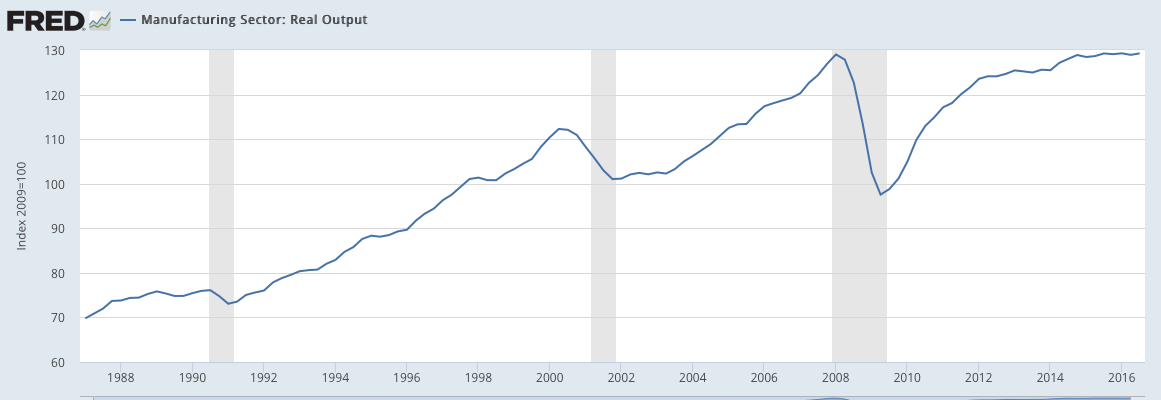Summary: Manufacturing output is at an all-time high. Manufacturing employment is at a post-industrialization low. Deregulation, dollar devaluation, and protectionist/isolationist policies will not resurrect manufacturing employment.
The Economist:
In the early postwar decades, the American economy grew at a healthy clip. Millions of Americans earned a middle class wage by working in manufacturing. In recent decades, rising inequality and the stagnation of middle class earnings have generated a wave of nostalgia for the postwar economy, and for manufacturing employment in particular. If only America hadn't lost its manufacturing edge, all would be well.
You might reasonably guess that manufacturing in the US is in a secular downtrend. It's not. Real output is at an all-time high (ATH). It has nearly doubled in the past 30 years.
Why then do we believe otherwise? The answer is manufacturing employment, which has been in a long-term secular decline. Manufacturing employment peaked in 1979. Today, it is about half of those levels.
Increasing global trade is not the primary culprit in the decline in US manufacturing employment. Again, output is at an ATH. Manufacturing jobs have fallen with new technology and other means for increasing productivity. The number of employees needed to make the same output has more than halved in the past 30 years.
Bear in mind that the complexity of products being produced has increased during this time. The increase in productivity is much more stunning when you look at it within the same industries.
Take steel production, for example. In the 1950s, it took 5000 workers to produce the same tonnage of steel that can today be produced with just 400 workers.
Coal is another example. Employment in coal mining today is about 60,000 workers, less than 1/3 of the levels 30 years ago. Yet since the early 1980s, output is about the same, having reached its ATH as recently as 2008.
The US economy has not been driven by manufacturing employment in decades. In 1953, more than 30% of total employment was in manufacturing. Today, it is about 8%.
The downtrend in the importance of manufacturing employment is more than 70 years old. No amount of deregulation, dollar devaluation, or protectionist/isolationist policies will resurrect employment in manufacturing industries. As The Economist summarizes:
The manufacturing employment downtrend predates the end of Bretton Woods. It predates the union-crushing, deregulating era of the late 1970s and early 1980s. It predates the era of Japanese dominance, the rise of the Asian tigers, and the recent surge in Chinese growth. A plunging dollar, a "get tough" approach to China, and an embrace of industrial policy won't reverse this trend.
The technology will continue to make old jobs obsolete. Truck driver is now the most common job in most states. Within the next decade, automated, self-driving vehicles are a distinct likelihood (data from NPR).
Hear next: Why Your Next Car Will Be Driverless (Podcast)













